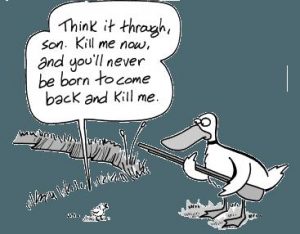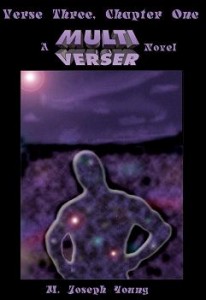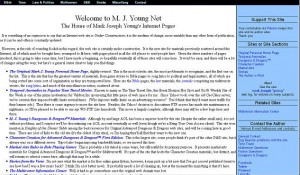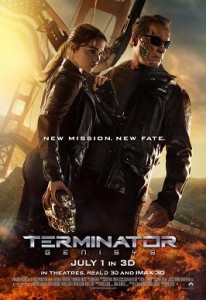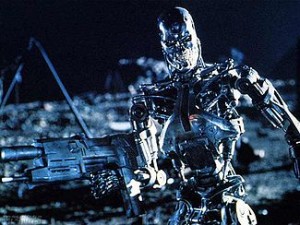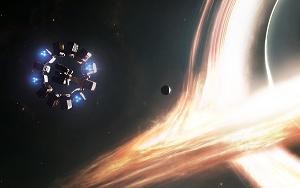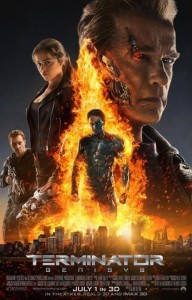This is mark Joseph “young” blog entry #81, on the subject of The Grandfather Paradox Problem.
A friend who was playing Multiverser with me before we were on Facebook tagged me in a post about a time travel video, in which someone offers a scientific solution to the famous Grandfather Paradox: what happens if I travel back in time and kill my own grandfather before he has children? As the cartoon below shows, if you did that, you would undo your own existence, and if you undid your existence you would not be able to travel to the past and do that.
There are already quite a few links in this page, and there undoubtedly will be quite a few more before we’re done, so I recommend ignoring them all until you’ve read the page, and then deciding whether there are any you particularly want to pursue.
The video inappropriately seems to suggest that this is “the scientific” answer and therefore the true one. That’s careless. It even recognizes the alternate dimension solution, dismissing it as “boring” (because it just avoids the paradox)–and we agree that it’s a poor solution, because whether we are speaking of parallel dimensions (a vast, possibly infinite, set of dimensions which have always existed) or divergent dimensions (the creation of new branching universes caused by the arrival of the traveler), it is not time travel. The video ignores other solutions, such as The Novikov Self-consistency Principle (in essence a fixed time theory solution which asserts time travel is only possible in universes in which the past is immutable). It also ignores replacement theory; we’ll get to that.
If the video is confusing to you, don’t be embarrassed: it’s a confusing theory. I think it’s the theory behind Dr. Manhattan’s perception of the world in Watchmen: it isn’t exactly that all possible worlds exist, it’s that they all co-exist within a single but complex spatio-temporal space.
One of the problems of divergent dimension theory is the question of where all the matter and energy originate to create another identical universe. That is, if you have a matter replicator on the order of Star Trek: The Next Generation, and you want to create a cup of tea, you need as much energy as you would obtain from the nuclear annihilation of an identical cup of tea, plus a bit more to operate the machine. If you want to create another identical universe, you would need to consume all the matter and energy of the original universe plus probably a bit more to do the work. Assuming you could do it, your original universe would have ceased to exist anyway.
- There are a few other problems with this. Since you had to use some of the energy to perform the process, you wind up with a slightly smaller replacement universe; and assuming that you have a time traveler who left that other universe, either he was destroyed when that universe was (creating the paradox we are attempting to avoid) or his matter and energy are not included in the total (shorting us yet a bit more). But those are extra quibbles.
If you maintain a divergent dimension theory idea without time travel, that is, that every choice, every possible occurrence, creates two universes, in one of which the event happened and the other it did not, you multiply this problem exponentially, since for anything I could be doing right at this moment there exists a universe in which I am doing that, and for everything you could be doing there exists a universe in which you are doing that, and as long as what we might be doing is compatible those two lists are multiplied–I do thing A while you do thing A, I do thing A while you do thing B, I do thing B while you do thing A, and by the time we get to four possible actions for two hypothetical people we have sixteen universes, and we have only gotten started.
The theory behind the solution offered by the video attempts to resolve that issue, and in a strictly theoretical way it does so rather cleverly. There are not innumerable copies of me; there is only one. That one individual exists as a bundle of matter and energy across all the many dimensions, and is doing all the different things he might be doing. My consciousness only remembers those events which are sequentially chained in the history of what I am aware of doing at the moment–I have no awareness of what I am doing or what I ever did in those other dimensions, but it is still me doing it.
The idea sprang from the problem addressed by that famous feline Schrödinger’s Cat. Because of some other theories in quantum physics the state of an unstable atom was viewed as problematic. It might decay at any moment, and therefore it might have decayed since you last looked. Someone (his name is not as famous as Schrödinger’s) proposed that the answer to this was that the atom existed in both a decayed and an undecayed state, and when you looked at it you determined not exactly in which state it was but rather in which universe you were observing it. Until you looked, it was both decayed and undecayed, and the act of looking determined the state. Schrödinger said that this was absurd, since if that were true he could set up an experiment in which a cat who would die the instant a specific atom decayed would be both alive and dead until someone checked, and since the cat cannot possibly be both alive and dead the theory is nonsense. However, the theory was immediately defended with the assertion that what Schrödinger claimed was impossible was actually the reality, that the cat actually is both alive and dead until someone looks and discovers whether we are in a dimension in which it is alive or one in which it is dead.
I don’t know that Schrödinger was persuaded, but the idea took hold and expanded, attaching to events that were not in any obvious way connected to the uncertainties of subatomic decay: suddenly anything that might have happened has happened, and all of us are both alive and dead, sitting in church and visiting a brothel, fabulously famous and desperately destitute, at the same time.
I have problems with that; I have addressed them on other pages. The present video does not venture there–it only discusses the notion that two such states could exist simultaneously, one in which my grandfather lived and led to my existence, the other in which I killed him, and so the fact that I both do and do not exist at this moment because of a future action I will take in the past is not a problem.
I still see it as a problem. Let’s get at it, though, by noting that I have a brother. (In reality I have two, and a sister, and a batch of cousins, nephews, neices, and cousins-once-or-twice-removed who might also be affected, but let’s stick to one brother.) We have talked about the problem of having a brother in multiple dimension theory before, but it’s a different problem in this version.
The problem is that when I kill my grandfather, I also rather inadvertently also kill my brother’s grandfather.
My reality is convoluted, but it is comprehensible. There is a reality in which I exist up to the moment–let’s call it “today”–when I leave for the past, and after that–“tomorrow”–I no longer exist because I left and never returned. There is another reality in which I was never born, and so “today” I do not exist and never existed, and that’s confusing–but tomorrow is somewhat simpler, because tomorrow I still do not exist because I never existed. In my experience, therefore, I both exist and do not exist today, but tomorrow I simply do not exist. Reality is unstable for a while, but then we might suppose that it stabilizes “today” when I leave for what we will call “yesterday”, stretching the term about a century to when my grandfather was a child.
What, though, of my brother? There is a reality in which he exists “today”, and since he does not leave to go back to “yesterday” he, in that reality, still exists “tomorrow”. Yet since I went back to “yesterday” and killed our young grandfather, there is a reality in which he was never born, either. My reality stabilizes into a universe tomorrow in which I do not exist–but his reality never does so. From the moment I either do or do not kill our grandfather, he either does or does not exist, and that never changes.
That’s very dramatic when we consider him; he is quite obviously impacted by whether or not I killed our grandfather. Yet it is not just whether or not he exists tomorrow; it’s whether we have existed in these intervening years, and what the shape of the future will be hereafter. We always discuss this as killing a grandfather before he has children, but that means there is that intervening generation–in which one of our parents was never born. Reflect on it and you’ll recognize that no matter what happened between your parents, their lives would have been very different had they never met, and if one of them had never been born, they would never have met. I have elsewhere written about the genetic problem. Note that had our mother not married our father, she probably would have married someone else; and whoever that was probably actually did marry someone else in this reality whom they would not have married had they married Mom. That ripples through hundreds, possibly thousands, of relationships, displacing couples and altering the identities of a large segment of the next generation which in turn multiplies the impact, as the couples marrying in that generation are altered by the fact that thousands of them were never born, replaced by thousands who were born instead. So it is not just my brother and I who both do and do not exist; it is thousands of others whose births will be prevented if my mother marries someone other than my father.
And when we reach the end of that bit of twisted time in which there are two different realities, one in which I live and leave for the past and the other in which I am never born, we have two worlds that are so completely different that it becomes utter nonsense to speak of them even as parallel. The counterpart for my brother Roy Young is probably someone like Vinnie de LaRosa, who also exists in one dimension but not in the other. The world has been so altered by this one event that the two versions can never converge to the same future. “Tomorrow” can never be unified.
At that point, whether we say that there is a diverging universe with its own history beginning from the moment of my arrival in the past or that there is only one universe in which the same matter is configured in different ways in various histories which diverge from each other becomes a matter of semantics which solve nothing. It is divergent universe theory with a lot of smoke and mirrors to make us think it is something else.
Meanwhile, the same action–killing your grandfather–in replacement theory causes an infinity loop. In essence, there is an original history in which my grandfather lived and I was born, and I departed for the past ending that history, and as I arrived in the past I erased the original history and began writing a different single history of the world in which my grandfather died young and I was never born; then at the moment I fail to travel to the past, I remove myself from the past (the exact reason the grandfather paradox is a problem) and create a history in which I am not there, my grandfather lives, and ultimately I am born–the original history restored, leading to my decision to travel to the past. Those two versions of history repeat, each causing the other, perpetually; “tomorrow” never comes, because it can only exist as a single universe with a single set of people and events if it has a single unified history in which all causes and effects are found.
So the video suggests an interesting idea that ultimately is not different from the divergent or parallel dimension theory it begins by dismissing. It is not really something different.
[contact-form subject='[mark Joseph %26quot;young%26quot;’][contact-field label=’Name’ type=’name’ required=’1’/][contact-field label=’Email’ type=’email’ required=’1’/][contact-field label=’Website’ type=’url’/][contact-field label=’Comment: Note that this form will contact the author by e-mail; to post comments to the article, see below.’ type=’textarea’ required=’1’/][/contact-form]
